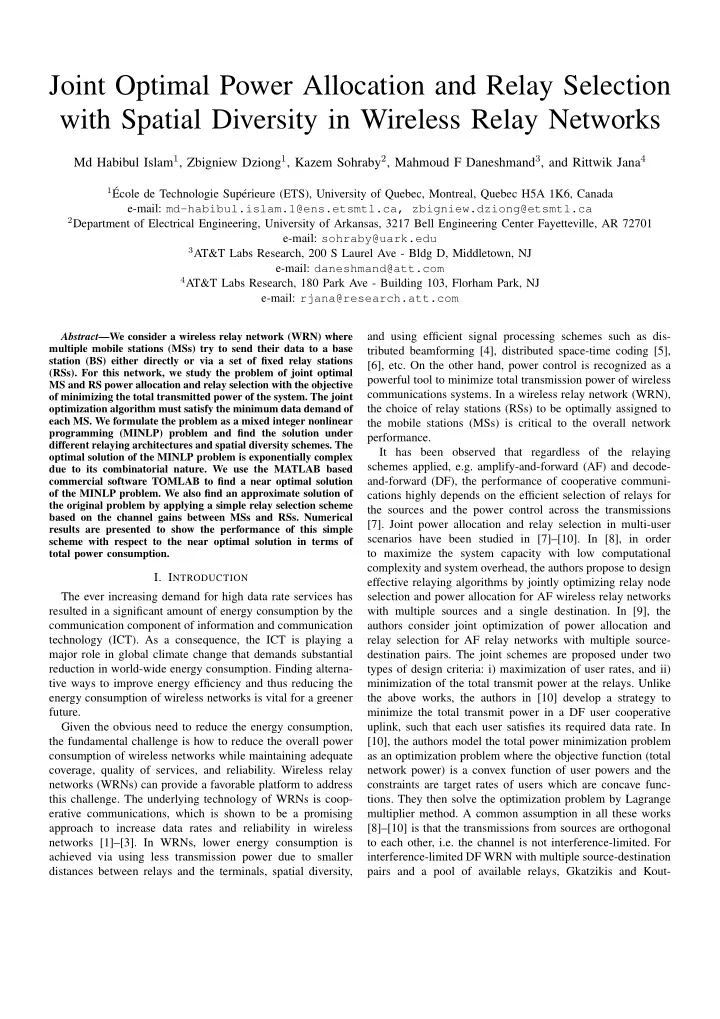

Joint Optimal Power Allocation and Relay Selection with Spatial Diversity in Wireless Relay Networks Md Habibul Islam 1 , Zbigniew Dziong 1 , Kazem Sohraby 2 , Mahmoud F Daneshmand 3 , and Rittwik Jana 4 1 ´ Ecole de Technologie Sup´ erieure (ETS), University of Quebec, Montreal, Quebec H5A 1K6, Canada e-mail: md-habibul.islam.1@ens.etsmtl.ca, zbigniew.dziong@etsmtl.ca 2 Department of Electrical Engineering, University of Arkansas, 3217 Bell Engineering Center Fayetteville, AR 72701 e-mail: sohraby@uark.edu 3 AT&T Labs Research, 200 S Laurel Ave - Bldg D, Middletown, NJ e-mail: daneshmand@att.com 4 AT&T Labs Research, 180 Park Ave - Building 103, Florham Park, NJ e-mail: rjana@research.att.com Abstract —We consider a wireless relay network (WRN) where and using efficient signal processing schemes such as dis- multiple mobile stations (MSs) try to send their data to a base tributed beamforming [4], distributed space-time coding [5], station (BS) either directly or via a set of fixed relay stations [6], etc. On the other hand, power control is recognized as a (RSs). For this network, we study the problem of joint optimal powerful tool to minimize total transmission power of wireless MS and RS power allocation and relay selection with the objective communications systems. In a wireless relay network (WRN), of minimizing the total transmitted power of the system. The joint optimization algorithm must satisfy the minimum data demand of the choice of relay stations (RSs) to be optimally assigned to each MS. We formulate the problem as a mixed integer nonlinear the mobile stations (MSs) is critical to the overall network programming (MINLP) problem and find the solution under performance. different relaying architectures and spatial diversity schemes. The It has been observed that regardless of the relaying optimal solution of the MINLP problem is exponentially complex schemes applied, e.g. amplify-and-forward (AF) and decode- due to its combinatorial nature. We use the MATLAB based and-forward (DF), the performance of cooperative communi- commercial software TOMLAB to find a near optimal solution of the MINLP problem. We also find an approximate solution of cations highly depends on the efficient selection of relays for the original problem by applying a simple relay selection scheme the sources and the power control across the transmissions based on the channel gains between MSs and RSs. Numerical [7]. Joint power allocation and relay selection in multi-user results are presented to show the performance of this simple scenarios have been studied in [7]–[10]. In [8], in order scheme with respect to the near optimal solution in terms of to maximize the system capacity with low computational total power consumption. complexity and system overhead, the authors propose to design I. I NTRODUCTION effective relaying algorithms by jointly optimizing relay node The ever increasing demand for high data rate services has selection and power allocation for AF wireless relay networks resulted in a significant amount of energy consumption by the with multiple sources and a single destination. In [9], the communication component of information and communication authors consider joint optimization of power allocation and technology (ICT). As a consequence, the ICT is playing a relay selection for AF relay networks with multiple source- major role in global climate change that demands substantial destination pairs. The joint schemes are proposed under two reduction in world-wide energy consumption. Finding alterna- types of design criteria: i) maximization of user rates, and ii) tive ways to improve energy efficiency and thus reducing the minimization of the total transmit power at the relays. Unlike energy consumption of wireless networks is vital for a greener the above works, the authors in [10] develop a strategy to future. minimize the total transmit power in a DF user cooperative Given the obvious need to reduce the energy consumption, uplink, such that each user satisfies its required data rate. In the fundamental challenge is how to reduce the overall power [10], the authors model the total power minimization problem consumption of wireless networks while maintaining adequate as an optimization problem where the objective function (total coverage, quality of services, and reliability. Wireless relay network power) is a convex function of user powers and the networks (WRNs) can provide a favorable platform to address constraints are target rates of users which are concave func- this challenge. The underlying technology of WRNs is coop- tions. They then solve the optimization problem by Lagrange erative communications, which is shown to be a promising multiplier method. A common assumption in all these works approach to increase data rates and reliability in wireless [8]–[10] is that the transmissions from sources are orthogonal networks [1]–[3]. In WRNs, lower energy consumption is to each other, i.e. the channel is not interference-limited. For achieved via using less transmission power due to smaller interference-limited DF WRN with multiple source-destination distances between relays and the terminals, spatial diversity, pairs and a pool of available relays, Gkatzikis and Kout-
Recommend
More recommend